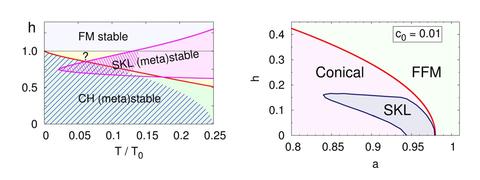The role of the thermal fluctuations in cubic helimagnets: stabilization of new phases at low temperature
The role of thermal fluctuations in the stabilization of the magnetic states that appear in cubic helimagnets is theoretically analyzed, using a saddle point expansion to obtain the free energy. It is shown that in the low temperature region thermal fluctuations destabilize the conical state and stabilize the skyrmion lattice (SKL) near the transition to the forced ferromagnetic state. Also, a new phase, whose features cannot be determined with our method, appears in this region of the phase diagram (Figure left) [1]. This new state, and the SKL at low temperature, have been recently found in Cu2OSeO3 [2, 3]. It is also shown that at high temperature and low field, near the phase boundary, thermal fluctuations stabilize the SKL, which becomes the equilibrium state (Figure right) [4]. Comparisons with recent experimental results [2, 3] and with the computations of Mühlbauer et al. [5] are given.

References
[1] V. Laliena and J. Campo, Phys. Rev. B96, 134420 (2017)
[2] F. Qian et al. Sci. Adv. 2018;4:eaat7323 21 (2018)
[3] A. Chacon et al., https://doi.org/10.1038/s41567-018-0184-y Nature Physics, (2018).
[4] V. Laliena, G. Albalate, and J. Campo, Phys. Rev. B98, 224407 (2018).
[5] S. Mühlbauer et al., Science 323, 915 (2009).
Javier Campo (University of Zaragoza, Spain)

